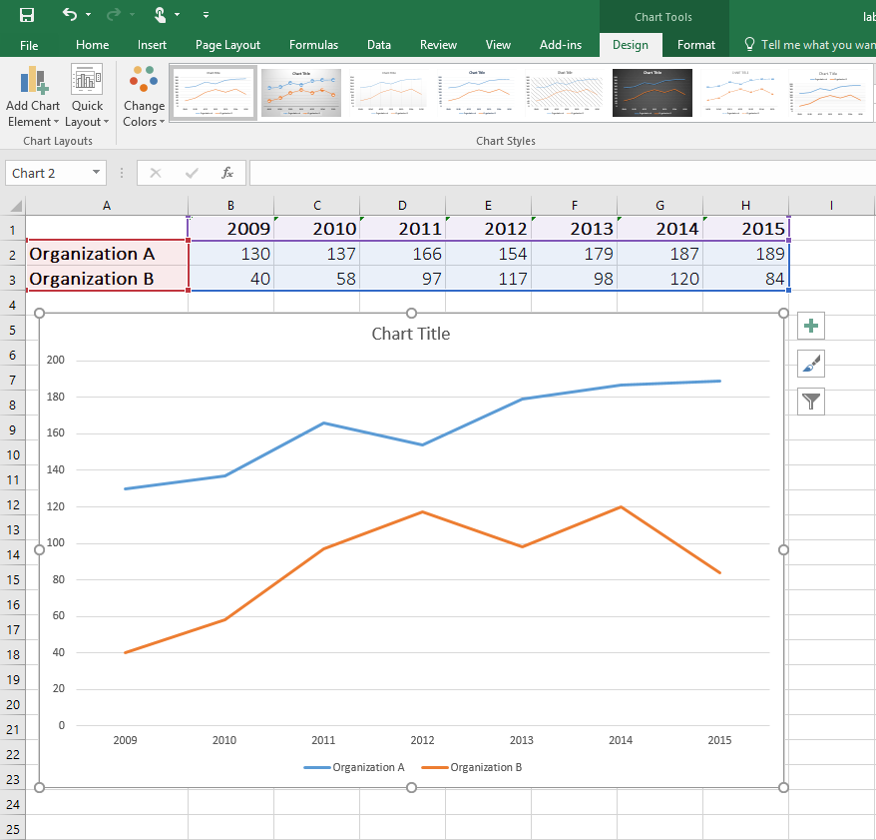
- #MICROSOFT EXCEL 2011 BREAK IN AXIS FOR MAC#
- #MICROSOFT EXCEL 2011 BREAK IN AXIS INSTALL#
- #MICROSOFT EXCEL 2011 BREAK IN AXIS TRIAL#
- #MICROSOFT EXCEL 2011 BREAK IN AXIS PLUS#
Then, I scale my data so it is visually meaningful on one of the two real axes that are available. My trick for adding an additional axis (or more) to an Excel chart it is create a data series that I plot vertically against the X axis which is scaled to reflect the range I need so that it spans the entire height of the chart. Having a third axis to dedicate to a third order of magnitude range (or a 4th or 5th or 6th if you needed them) makes it easier for me (and I think others) to intuitively read the chart. That worked, but it was kind of confusing in a way. Prior to the insight that lead to the technique I will show in this post, they way I dealt with the need to plot more than two data series with wildly different orders of magnitude was to scale one or more of them so they would be visually meaningful on one of the two axis I had available, and then include the scaling factor in the name of the series.įor instance, to plot the number of chillers running on the same axis as temperature, I might have multiplied the number of chillers running by 10 and then plotted it as Number of Chillers Running x 10.

Tonnages and flow rates that would fall in the 0 – 15,000 gpm/ton range against.Temperatures that would all fall into the range 0-100☏ against.In other words, to get something visually meaningful 1, I needed to plot: One of the challenges that came up when I was creating the time series graph of a 9,000 ton chiller plant load profile that I show in my previous post was that I wanted to plot data series that had numbers in them with very large differences in the order of magnitude. But it also now includes a more practical example in the form of a chiller kW per ton profile. Mostly, I improved the instructions to make it more user friendly.
#MICROSOFT EXCEL 2011 BREAK IN AXIS INSTALL#
Microsoft Excel 2011 is a much improved version of the famous spreadsheet tool that takes full advantage of OS X.ĭownload and install free mac app file for Microsoft Excel 2011.Authors Note : I made some improvements to the third axis tool that is mentioned in this post and uploaded it to the page associated with it on the Commissioning Resources web site. Note however that at the moment, Microsoft Excel 2011 is only available in a 32-bit version. Finally, sharing and collaborating on documents has been made much easier thanks to integration with SkyDrive and SharePoint. You'll also notice that the new Excel is much lighter on resources than previous releases - it leaves hardly any footprint on your CPU resources.
#MICROSOFT EXCEL 2011 BREAK IN AXIS PLUS#
Spotlight is also now supported to make searching documents much easier on your Mac.Īll the old features are there including the advanced filtering and analyzing of data plus a few more useful analyzing options that make Excel such a powerful tool.


The biggest innovation has been the introduction of the Ribbon to Microsoft Excel 2011 which makes navigating and editing your documents much easier and brings it into line with the Windows version. It's also now part of Office 365 which integrates Microsoft Office with the Cloud. Microsoft Excel 2011 is part of Microsoft Office 2011 and has been given a through revamp since Office 2008 including a slicker OS X style interface, lots of new templates and new sharing options.
#MICROSOFT EXCEL 2011 BREAK IN AXIS FOR MAC#
Microsoft Excel 2011 for Mac is the latest version of the most popular spreadsheet application in the world, now with the added bonus of much better OS X integration. The Download button for this program will redirect you to the Microsoft Excel 2016 page.
#MICROSOFT EXCEL 2011 BREAK IN AXIS TRIAL#
IMPORTANT NOTE: Microsoft Excel 2011 free trial is no longer available.


 0 kommentar(er)
0 kommentar(er)
